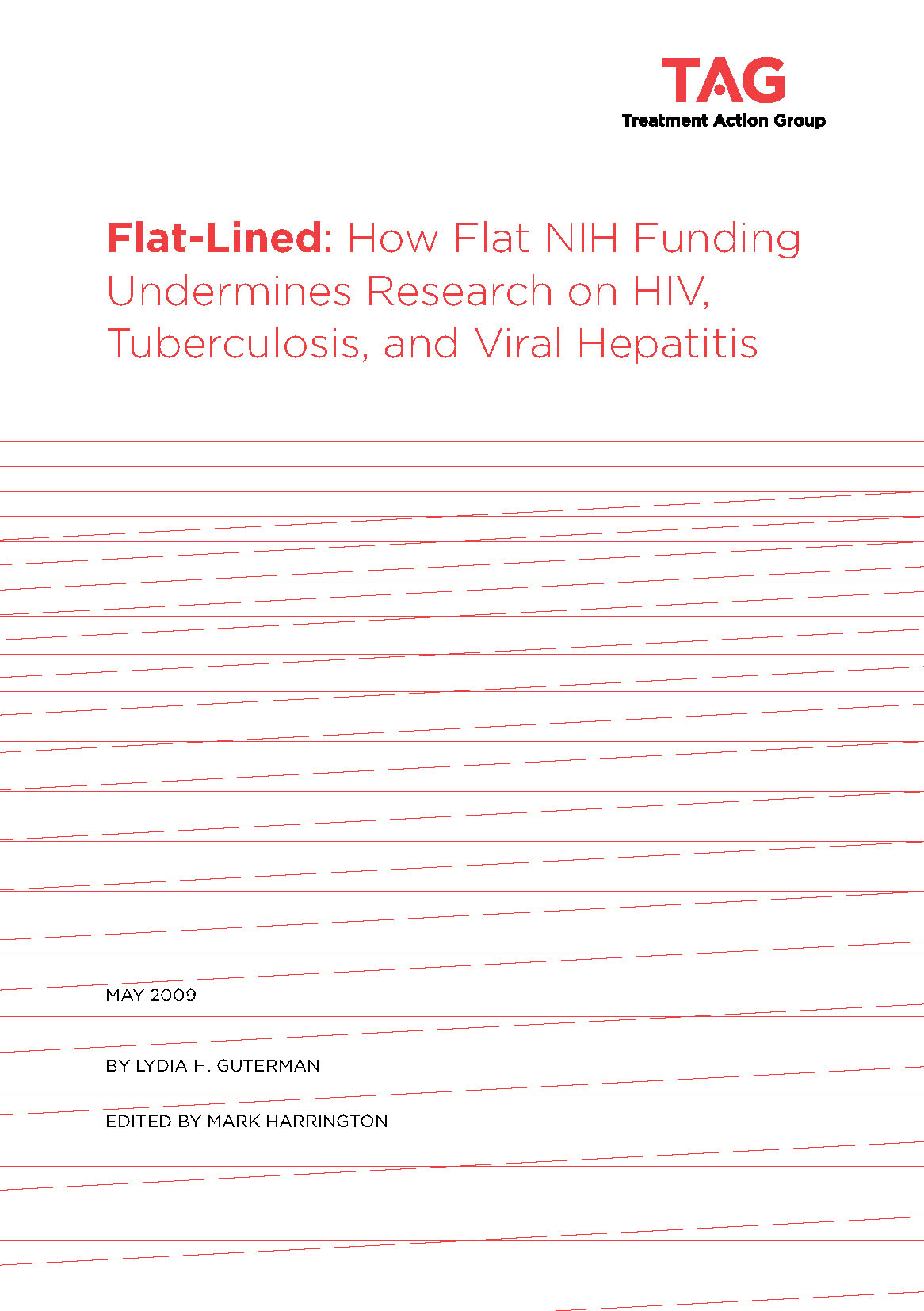May 2009
by Lydia H. Guterman
Edited by Mark Harrington
Executive Summary
The goal of this funding analysis is to provide a comprehensive picture of the current state of U.S. National Institutes of Health (NIH) research investment in HIV/AIDS and three of its most common coinfections—hepatitis B virus (HBV), hepatitis C virus (HCV), and tuberculosis (TB)—after five years of flat funding at the NIH (2004– 2009). For HIV/AID S research, the NIH Office of AIDS Research (OAR) provided TAG with consistently coded, cross-institute, NIH-wide data, but for HBV, HCV, and TB there is no central, consistent, dollar-denominated, and publicly available reporting mechanism for disease-specific, cross-institute NIH investment. Thus, the 2007 portfolios of hepatitis B, hepatitis C, and tuberculosis research were pieced together from data provided by each of the relevant NIH institutes and centers (ICs).
During the current period of flat funding (2004–2009), slight, nominal annual increases to the NIH budget have been outpaced by rising biomedical inflation, as measured by the biomedical research and development price index (http://officeofbudget.od.nih.gov/UI /GD P_FromGenBudget.htm; see figure 4, “Inflation Eroded Gains in NIH Funding,” on page 3). While nominal NIH funding rose from $27 to $29 billion between fiscal year (FY) 2003 and the FY 2009 president’s budget request, funding adjusted for biomedical inflation has decreased (in constant dollars) by 13.4% since 2003. In constant 2003 dollars, then, the 2009 NIH budget is just about $23 billion, or $4 billion less in 2003 dollars than actual funding in 2003 itself (Fauci 2008).
NIH investment in HBV, HCV, and TB research remains inexplicably low in light of the rapidly increasing global burdens of each of these diseases as epidemics in their own right and as the most common serious HI V-associated coinfections worldwide. Domestically, HBV, HCV, and hepatitis/HIV coinfection contribute a particularly high burden of disease.
In FY 2007, NIH spent approximately 10% of its budget on HIV/AIDS but only 1.1% on HBV, HCV, and TB combined. More than half (52%) of all programs for HIV/AIDS and these three diseases were administered by the National Institute of Allergy and Infectious Diseases (NIAID).
Under flat funding, new initiatives and expansions of research on HIV/AIDS and the three most common coinfections cannot go forward. As the real value of the NIH budget contracts, it is likely that more conservative research proposals by experienced NIH researchers will trump higher-risk (and potentially higher-reward) proposals submitted by early-career researchers. This discourages innovation and has likely already led to missed opportunities for the funding of novel approaches in the prevention and treatment of HIV/AIDS and its common coinfections.
The “Stimulus Bill,” aka the American Recovery and Reinvestment Act of 2009 (ARRA), will not, by itself, resolve the problem of longer-term flat funding of the NIH.
- At first glance, the $10.4 billion allocated by Congress to the NIH for FY 2009 and FY 2010 in the ARRA, signed by President Obama on February 17, 2009, appears to offer a long-sought remedy to the many years of flat funding that this report discusses. However, upon looking into the details of the act, and after discussions with senior NIH leadership, it is clear that while there will be short-term opportunities under the Act,
- the ARRA was not intended to raise the baseline funding level of the NIH
- spending from the stimulus will have to be completed by September 2011
- most spending will be determined by individual NIH institute directors (and not by the OAR) based on “recently peer reviewed, highly meritorious R01 applications from scientists across the country,” and “new R01 applications . . . that have a reasonable expectation of making progress in two years.” (NIH 2009bi)
- Thus, it remains critical to focus on increasing the baseline NIH funding levels proposed in the president’s FY 2009 and FY 2010 budget, expected to be submitted to Congress in April 2009, and in following years, by at least 15% per year for five years, or by at least 10% per year for ten years, over the rate of biomedical inflation.
Recommendations
- To counteract the past five years of flat funding and lost purchasing power and to set the NIH budget back on track, TAG recommends that the overall NIH budget increase by 15% per year for at least five years, starting in 2010.
- Faced with the increasing global burden of HBV, HCV, and TB, the NIH must significantly increase its investment on research in these three diseases.
- TAG has previously recommended (Feuer 2006, 2008ii) that funding for TB research should increase fourfold to achieve the targets set out in the Global Plan to Stop TB: 2006–2015.
- TAG further recommends that the NIH increase its annual investment in research on hepatitis B virus (HBV) infection fourfold.
- TAG further recommends that the NIH increase its annual investment in research on hepatitis C virus (HCV) infection fourfold.
- To avoid double counting of the same research dollars for multiple diseases, reporting of disease-specific research investment across NIH institutes requires better coordination. NIH-wide, disease-specific awards listings should be available through a centralized reporting mechanism freely available online.
i. National Institutes of Health. NIH’s Role in the American Recovery and Reinvestment Act (ARRA). www.nih.gov/about/ director/02252009statement_arra.htm. ( 25 February 2009). Accessed 25 February 2009.
ii. Feuer C. Tuberculosis Research and Development: A Critical Analysis. Edited by Javid Syed and Mark Harrington with Bob Huff. Treatment Action Group. New York, October 2006. https://www.treatmentactiongroup.org/tbrd2005 Accessed 9 March 2009.
Feuer C. TB Research and Development: A Critical Analysis of Funding Trends, 2005–2006: An Update. Edited by Mark Harrington, Bob Huff, and Javid Syed. https://www.treatmentactiongroup.org/tbrd2005-2006. Accessed 9 March 2009.

